Gooseberry varieties for the Moscow region, resistant to powdery mildew
The sweet and sour taste of gooseberry is familiar from childhood. Elastic and juicy berries are eaten fresh, used to prepare fruit and berry salads, healthy drinks and desserts. Gooseberries are yellow, green, red. To taste, it is divided into sweet and sweet and sour. In this article, we will tell you which gooseberry to plant in the Moscow region, pay attention to the description of varieties, gardeners' reviews, planting and crop care rules.
The content of the article
The best varieties of gooseberries for the Moscow region
The Moscow region is suitable for growing all fruit crops. In these lands, mild winters and moderately warm summers, frosts are rare.
When choosing a gooseberry variety, attention is paid to the ripening time, care requirements, plant immunity to diseases and pests.
Powdery mildew resistant
Powdery mildew - This is a fungal disease resulting from high humidity, improper feeding, due to contaminated land. A white bloom appears on the leaves, the plant withers. If preventive or therapeutic measures are not taken in time, the gooseberry will die. Therefore, it is recommended to grow varieties that are immune to this disease.
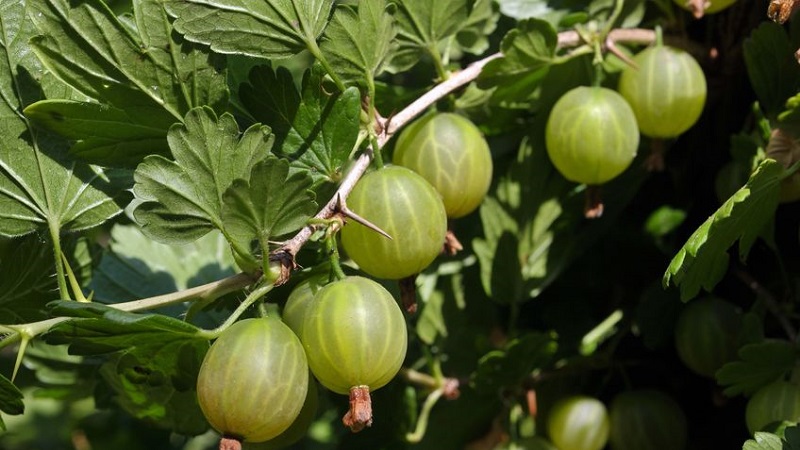
Defender
Medium late ripening variety. Bushes of medium size, straight shoots are completely covered with thorns. The berries are round-pear-shaped, the color is maroon or black, depending on the ripening period. There is a slight waxy coating. The berry weight is about 4 g, the yield per bush is up to 5 kg. The taste is pleasant, the flesh is sweet. In application, gooseberry Defender is versatile.
Russian yellow
Bushes are medium-sized, powerful shoots, grow straight up. The berries are large, the weight of one reaches 6 g. The color is yellow with a waxy bloom. The pulp is pleasant, sweet dessert taste. The shape of the fruit is round, slightly flattened on the sides. The yield reaches 10 kg per bush over the summer. Bushes Russian yellow have an attractive appearance, which makes this variety even more popular with gardeners.
Spring
The spring is resistant not only to powdery mildew, but also to other common diseases of culture and insect pests. Bushes are compact, suitable for growing in small garden areas. Berries are oval-round, weighing up to 5 g, green-yellow in color. Productivity - about 5 kg per plant. The taste is sweet, without sourness.
Large-fruited
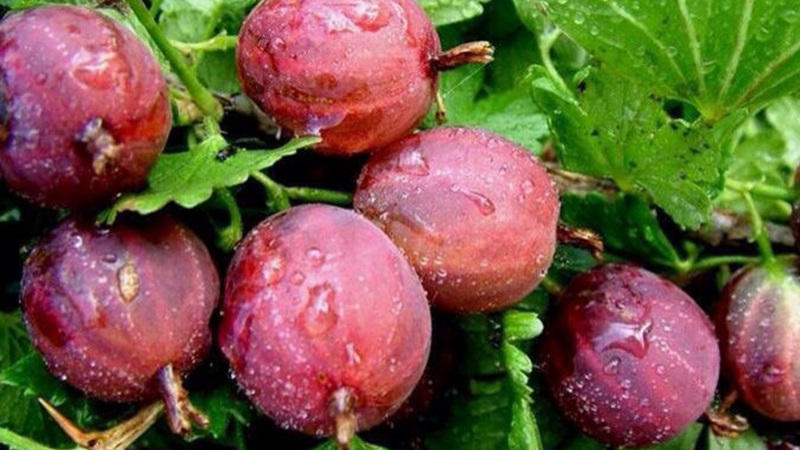
Large-fruited gooseberries are used fresh - the sweet pulp is to everyone's taste. Also, berries are used to prepare dessert dishes - they make jams and compotes, add to muffins or pies.
Gingerbread man
Medium-sized bushes with dense foliage. The weight of one fruit is about 7 g, the shape is round-oval, the color is light red. The taste is sweet and sour, refreshing. In the cultivation of gooseberries Gingerbread man unpretentious, has attractive commercial qualities. Productivity - 8-10 kg per plant per season. Thanks to their dense skin, the berries are resistant to cracking.
Cooperator
The crown of the variety is rare, the shoots are poorly covered with thorns, the height of the bush is no more than 1 m. The berries are pear-shaped, the color is dark red. The taste is sweet, rich. Gardeners from one bush harvest up to 5 kg of harvest, the weight of one berry is about 7 g.Gooseberry Kooperator is appreciated for its transportability and keeping quality - it retains its taste and marketability.
Beryl
The dessert variety is appreciated for its sweet berry aroma and juicy taste. The berries are used in cooking or eaten fresh. The bushes are medium-sized, the crown is compact. The berry weight reaches 9 g, the yield per bush is about 6 kg. The skin is thin, the color is light green, attractive. The variety is resistant to moisture and frost, does not require special skills in care.
Attention! If the summer is rainy, it is recommended to postpone watering the bushes for a while. It is better to pay attention to mulching - put cut grass, sawdust, sand, small stone at the base of the bushes. Mulch improves soil microclimate, strengthens plant immunity.
The most delicious and sweetest
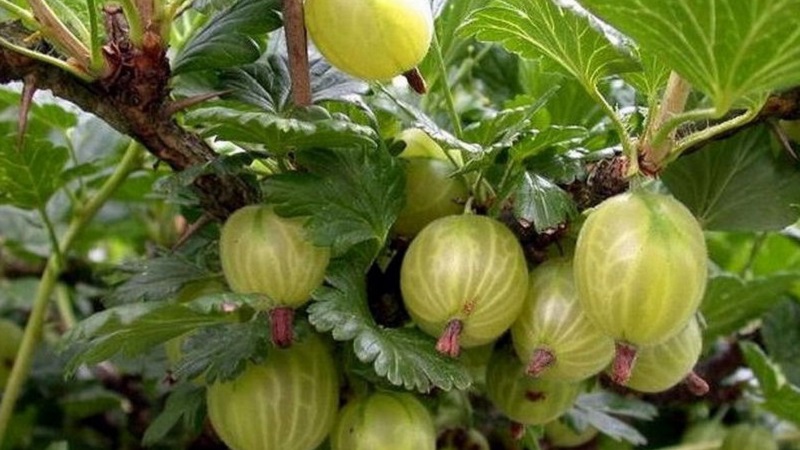
Sweet gooseberries are not only a delicious summer treat, but also a source of vitamin C and trace elements. You want to eat juicy berries right from the bush - they exude a sweet aroma and look very appetizing.
Sadko
Medium-sized bushes with a compact crown. The berries are firm, weighing about 6 g. The color is light pink or red, the taste is delicate and juicy, without bitterness and sourness. The gooseberry is round, slightly elongated. Productivity - about 2 kg per 1 sq. m. An ideal variety for those who prepare jams and preserves for the winter.
Pink 2
The berries are large, the weight of one reaches 10 g. The skin is dense, so after harvesting the gooseberry does not crack. Few thorns, medium-sized branches. The weight of one berry varies from 4 to 8 g. The taste is rich and juicy. Gardeners use the crop to prepare meals and freeze or dry them for the winter. The yield of the Pink 2 variety is about 5 kg per plant.
Belarusian sugar
Bushes are compact, erect, few thorns. The average berry weight is 5 g, the yield is up to 6 kg per bush. Gardeners appreciate the Belarusian sugar variety for its stable yield, unpretentious care, and disease resistance. The pulp is sweet, fibrous. The color of the berries is light green, the peel is of medium thickness.
No thorns
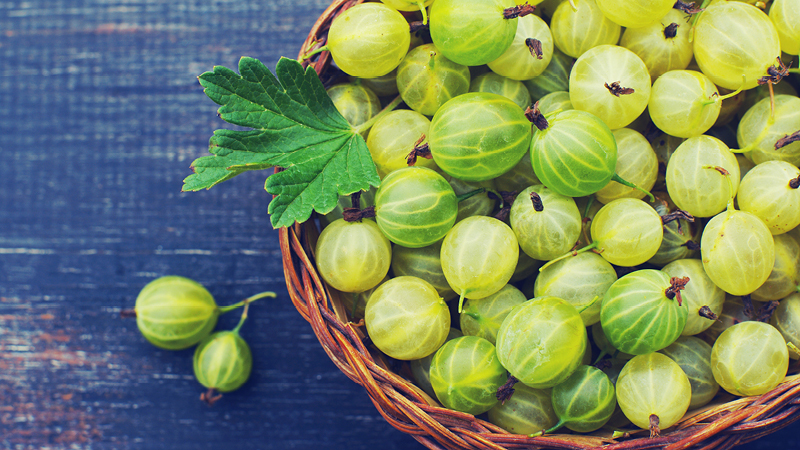
Thornless gooseberries are a godsend for any gardener. Hands will remain safe and sound, no scratches. When choosing a variety, many pay attention to this very criterion.
Sirius
The berries are medium in size and round in shape, weighing about 4 g. The color is dark red, the peel is dense, with a waxy bloom. The taste is sweet with a refreshing sourness, the pulp is juicy. The berries are heterogeneous in size, universal in use. The Sirius variety is distinguished by frost resistance and immunity to fungal and viral diseases. Productivity - up to 3.5 kg per bush.
Naughty
On medium-sized bushes with a compact crown, there are not a single thorn. Berry weight - up to 4 g, light green color. The skin is thin, the waxy coating is weak. The taste is sweet with a rich berry aroma. Housewives use the crop for conservation. During the season, gardeners collect about 4 kg from one bush.
Anniversary
Gooseberry Anniversary is grown not only in the Moscow region, but also in the northern regions of the country. The variety is characterized by frost resistance and strong immunity. Slightly spreading bushes, strong shoots. The berry weight is 5-7 g, the skin is dense, the color is red with a yellowish tint. The pulp is sweet and sour, the aroma is pleasant. Productivity - from 4 to 8 kg per bush. The commercial and taste qualities of berries are not lost during transportation and storage.
Interesting! Due to its sweet and sour taste, the gooseberry Yubilyar is suitable for making refreshing fruit drinks. Gruel is made from berries and poured with cool clean water. Add mint, lemon, lime, and other berries to taste.
Self-fertile
Self-fertile varieties are suitable for growing in compact garden areas - they do not need pollinating plants. Such gooseberries do not need insects either, which gardeners highlight as an advantage. You don't have to worry about the harvest - the number of berries does not depend on the presence of bumblebees, wasps and other pollinators.
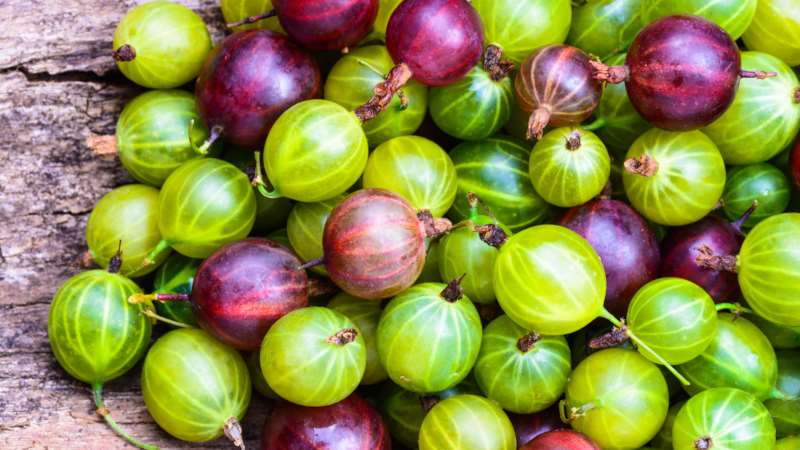
Kazachok
The mid-late variety is distinguished by its unpretentiousness and winter hardiness.The yield is up to 5 kg per plant, the berries are juicy and sweet, the weight of one is about 5 g. The color is burgundy or dark pink, there is a weak waxy bloom and light white stripes. Few spines, medium-sized branches. The appointment is universal, it is rarely affected by powdery mildew and anthracnose.
Krasnoslavyansky
Beautiful berries of deep pink color ripen by mid-summer. The weight of one is about 8 g, the yield is 6 kg per bush over the summer. The taste is sweet with a slight sourness, rich berry aroma. The variety is resistant to insect pests, unpretentious in care. Krasnoslavyansky is appreciated for its marketable quality and keeping quality.
Malachite
A popular gooseberry variety takes root in any region. Productivity - up to 7 kg per plant, berry weight - 5 g. The color is rich light green, the peel is covered with a waxy bloom. The taste is sour, the harvest is used for conservation - they prepare jam and jams for the winter. There are few thorns, so picking gooseberries is not a hassle.
Planting and caring for gooseberries in the Moscow region

The yield of the gooseberry depends not only on the variety, but also on compliance with all agrotechnical rules for planting and care. Gooseberries are unpretentious in cultivation; the main thing is to take care of him in accordance with the basic recommendations.
When is it better to plant - in autumn or spring
In the Moscow region, planting gooseberries is popular in autumn - at the end of September or early October, before the first frost. Winter in the Moscow region is warm, so the seedlings quickly take root and adapt to new conditions. In the spring, planting gooseberries is not prohibited. The main thing is that the seedlings have time to take root in the soil before the onset of warm weather.
Planting rules and process
For planting, choose one-year or two-year seedlings. Everything is carefully removed from them. leaflets and check for fibrous roots - they should be well developed. The seedlings are prepared - the roots are dipped into a special composition (clay, black soil, growth stimulant "Kornevin") and left for a day. This method strengthens the plant's immunity and helps it in the future to quickly adapt to the climatic conditions of the Moscow region.
Attention! Gooseberries love light and warm areas. It is recommended to plant the plant along the fence. Suitable precursors for planting are potatoes, peas, carrots, beets, peppers. It is not recommended to plant gooseberries next to raspberries, black or red currants.
Light and neutral soil is suitable for planting. A recess measuring 40x40x40 cm is made in it, a quarter is filled with compost and the roots of the seedling are placed. The root collar should be underground at a depth of 5 cm. The base of the seedling is sprinkled with earth, watered abundantly with warm water and mulched.
Watering and feeding the bush
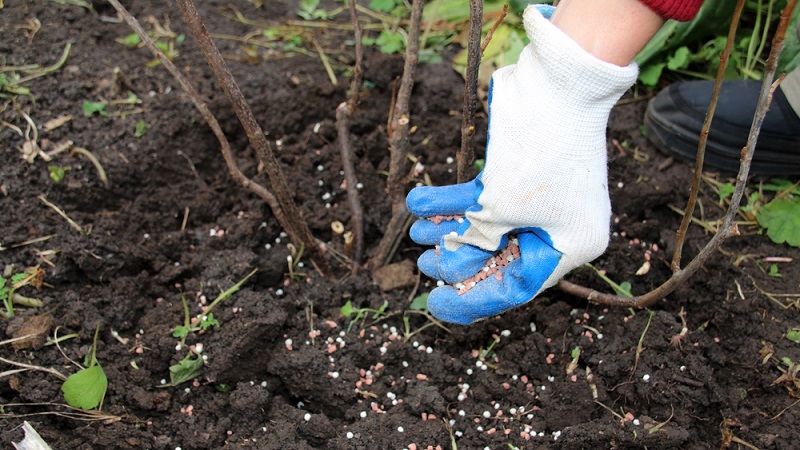
Before watering, a small groove 15 cm deep is pulled out near each bush. About 10 liters of water are spent on young bushes, and about 30 liters on adult plants. The first watering is carried out during the formation of ovaries. The second is during the ripening of the fruit. To avoid moisture evaporation, after watering the bushes are mulched with peat or compost. It is recommended to water the berries in the evening or in the morning to avoid sunburn. It is advisable that the water falls directly under the roots, and not on branches, berries or leaves.
Attention! Overmoistening gooseberries leads to the development of fungal and viral diseases. Experienced gardeners recommend marking the day of watering in the calendar.
Fertilize gooseberries several times per season. The first feeding is a solution of a mullein in a ratio of 1:10, the second is a mixture of organic and mineral components. To prepare the composition, use warm water (3 l), potassium sulfate (8 g), superphosphate (20 g). It is recommended to fertilize after harvest.
Pruning

Each season, gooseberries produce many new shoots, which make harvesting difficult and serve as a suitable breeding ground for insect pests. The first pruning is carried out immediately after planting the seedlings in the ground - no more than 5 cm of shoots are left above the ground.
Adult plants are cut by a third before winter.It is important to remove dry, weak and damaged branches in time in order to give young and healthy growth. It is recommended to carry out the procedure in the fall, so that in the spring it is only to remove the frozen branches.
Shelter for the winter
Despite the moderately warm winter, gardeners in late autumn or early winter cover the gooseberries with a dense cloth, burlap or diaper. Before this, the branches are neatly tied together, laid on the ground and pressed with a board. If snow has already fallen, you can sprinkle the shoots. Before sheltering, the bush is watered abundantly with warm water.
The shelter is removed only in April or May, when all the snow has melted and the probability of frost has passed. After a few days, the bush independently moves away from the ground, straightens and takes on the desired shape.
Ripening dates for gooseberries in the Moscow region
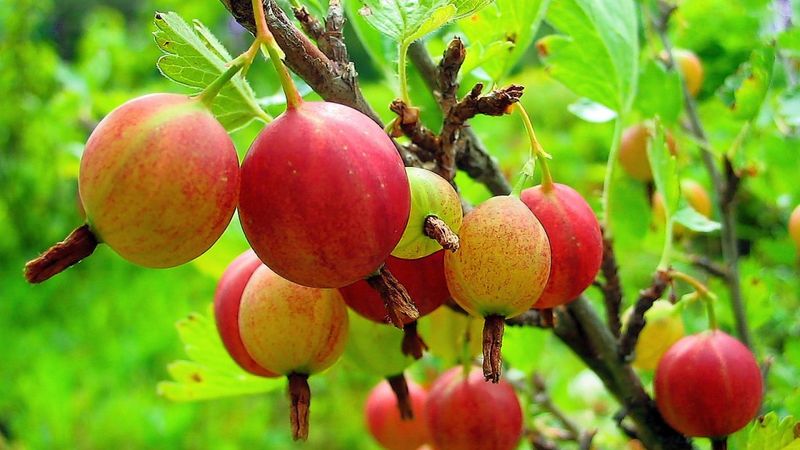
Early varieties ripen by the end of June or early July, mid-ripening ones - by mid-summer. The ripening period depends on weather conditions, compliance with the rules of planting and care. Late varieties ripen by July 20-25 or early August. Gooseberries do not ripen well, so gardeners pick berries in several stages. Fruiting in most varieties lasts 20-30 days.
Attention! The ripeness of the gooseberry is determined by the color and size of the berry. Ripe fruits are easily separated from the stalk and have a pleasant berry aroma. The skin becomes thin, slightly translucent in the sun.
Conclusion
The Moscow region is great for growing gooseberries. It is recommended to plant the berries in warm and sunny areas, away from raspberries and currants. For planting, one-year or two-year seedlings are used, placed in a prepared hole, watered and mulched.
Care consists of watering, fertilizing, pruning and shelter for the winter. Gardeners of the Moscow region love the varieties Kazachok, Shalun, Pink 2, Sirius. Some taste sweet berries, others with a refreshing sourness. Also popular are the studless and self-fertile varieties Yubilyar, Krasnoslavyansky, Malachite.